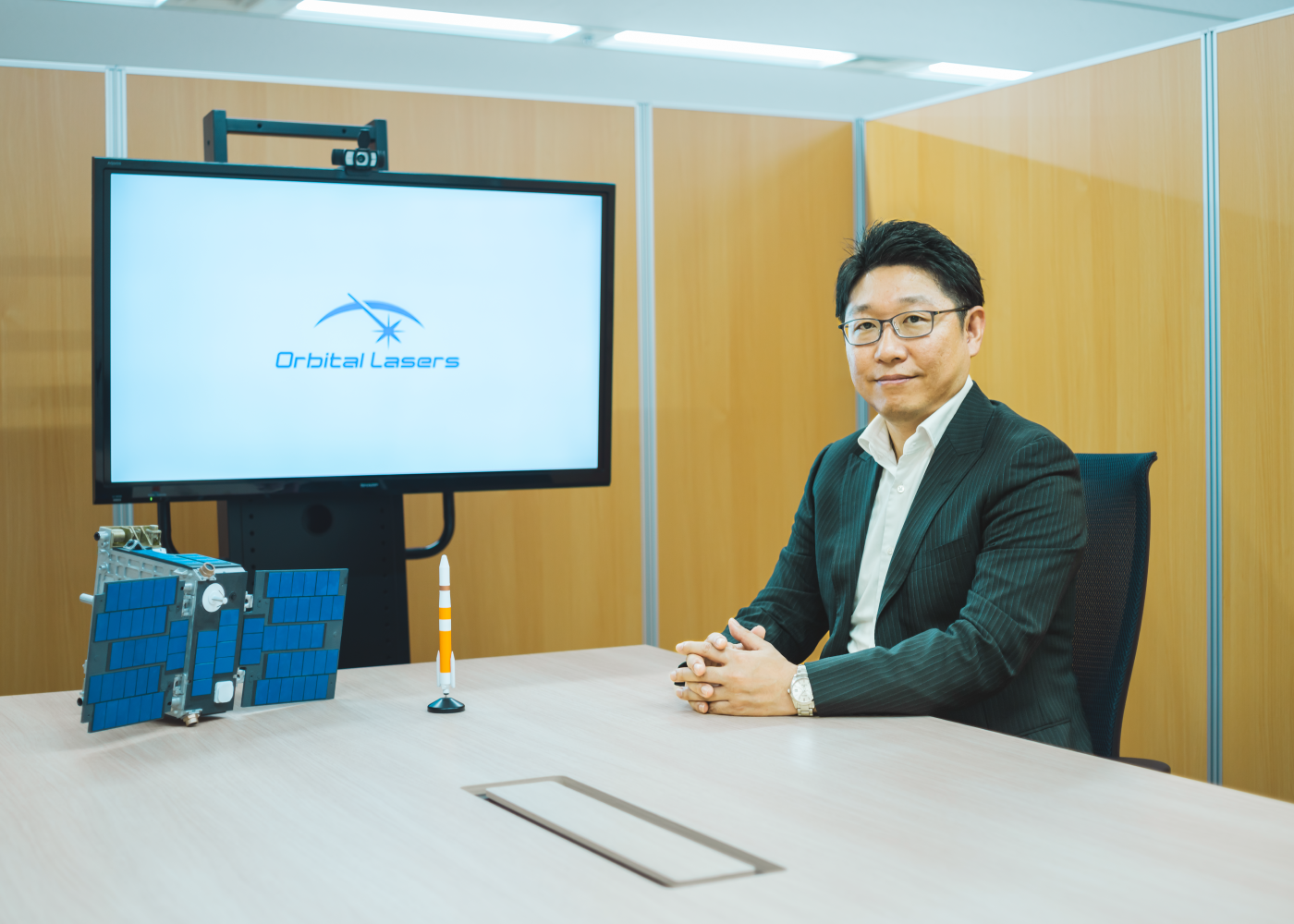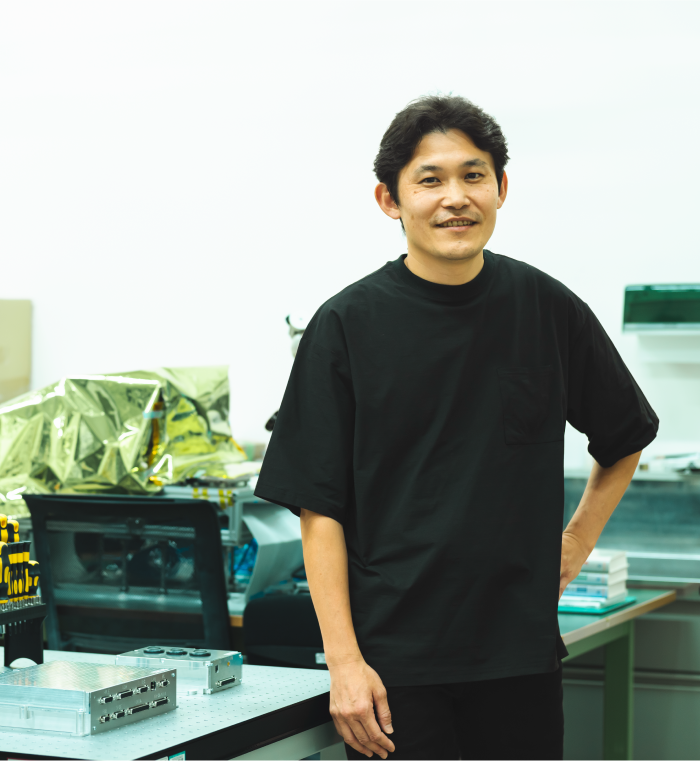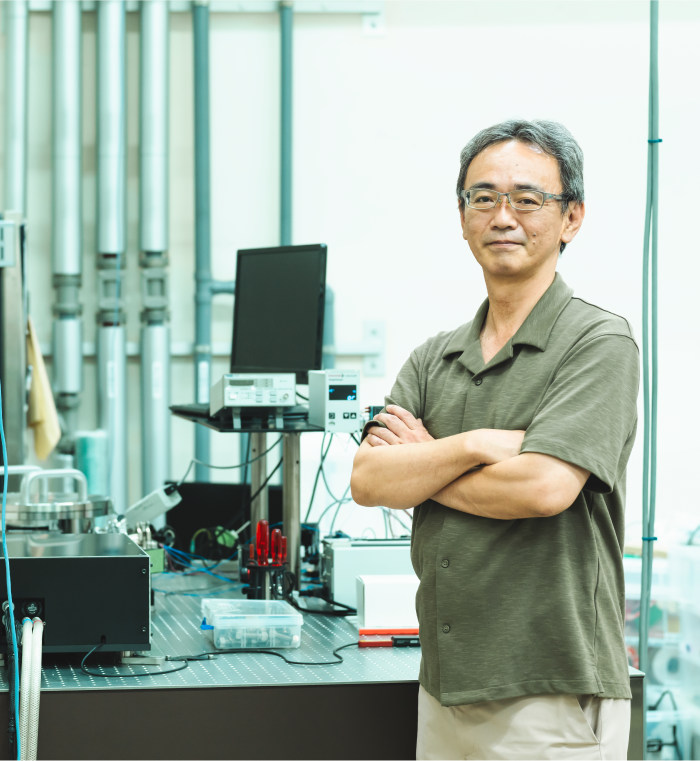
Interview
学び支え合うチームが
私たちの誇り。社会を
変革するサービスを、
ともに創り上げる
Our Pride is a Supportive Team That Learns Together.Together, we develop services that transform society.
福島 忠徳
代表取締役
Tadanori Fukushima
Representative Director and CEO


Special
Message
私たちとともに
新しい未来を作る
仲間を募集します
We invite enthusiastic teammates to join us in shaping a new future together.
スカパーJSATで約14年間、衛星の運用、衛星管制システムの構築、軌道制御、宇宙物体の衝突回避運用などに関わっていた福島氏。国立研究開発法人理化学研究所等と連携しながら、2018年にはスカパー JSAT 内のスタートアッププログラムにおいて、レーザー技術でスペースデブリ問題の解決を目指すプロジェクトを発足。2024年1月には、「宇宙とレーザー」を軸に自ら、株式会社 Orbital Lasersを設立。高精度な地表面情報を提供する「衛星ライダー」事業も始動し、さまざまな領域のエキスパートとともに、新たな社会価値の創出に挑んでいる。
Mr. Fukushima has dedicated approximately 14 years at SKY Perfect JSAT to satellite operations, constructing satellite control systems, managing orbital control, and conducting space object collision avoidance operations. In 2018, he launched a project within SKY Perfect JSAT’s startup program, collaborating with institutions like the National Institutes of Natural Sciences and RIKEN to tackle the space debris challenge using laser technology. In January 2024, he founded Orbital Lasers Co., Ltd. focusing on "space and lasers." The company has also initiated its Satellite LiDAR business, delivering high-precision surface data, and is collaborating with various experts across different fields to create new societal value.
Q1. Orbital Lasersを設立して感じること
Q1. Reflections on Establishing Orbital Lasers
技術の先にある未来を見据え
自分のミッションをとことん楽しむ
それが組織全体の、大きなエネルギーを生み出す
Focusing on a future beyond technology and fully embracing my mission is what fuels great energy within the organization.
スカパーJSATで宇宙事業に従事していた頃と、Orbital Lasersを設立した今とでは、環境も雰囲気も全く異なります。大きな違いは、関わる人々の「熱量」と「覚悟」でしょう。Orbital Lasersのメンバーは、「宇宙用レーザー」を単なる技術と見なしていません。全員が、この技術で社会価値をもたらすという、技術の先にある未来を見据えているのです。そのため、どんな状況でも、同じ方向を向いて、全力で進んでいけるチームだと感じています。自分に課せられたミッションを楽しんでいるメンバーばかりで、その姿勢が組織全体のエネルギーにもなっています。私自身も毎日の仕事にやりがいを感じており、もはや「仕事」なのか「人生」なのか、境界が曖昧になるほど。この素晴らしいメンバーとともに、事業を育てていけることが、私の何よりの喜びです。
The environment and atmosphere at Orbital Lasers are vastly different from my time in the space business at SKY Perfect JSAT. The most significant change is the "passion" and "commitment" of our team. Members of Orbital Lasers don’t view "space lasers" as just a technology; they are dedicated to realizing the positive impact this innovation can have on society. This shared vision propels us forward with determination, regardless of the challenges we face. Our team consists of individuals who genuinely enjoy the mission they have been entrusted with, generating energy throughout the organization.
Personally, I find great fulfillment in my daily work to the extent that the line between "work" and "life" has blurred. The greatest joy for me is nurturing this business alongside such remarkable team members.
Q2. ふたつの事業の進捗について
Q2. Progress of the Two Projects
「スペースデブリ除去」の技術開発は、佳境に。宇宙大航海時代における重要なピースとして、いよいよ実用化へ
The development of space debris removal technology is entering a critical phase, positioning it as a key component of the new era of space exploration, now on the verge of practical application.
「スペースデブリ除去」事業では、世界的に深刻化する宇宙ゴミ問題に対して、「遠隔からデブリの運動を把握し、レーザーで力を与えて動かす」という画期的なアプローチで解決を目指しています。2024年度内には、レーザー、電源、送光望遠鏡、制御用コンピュータ、アルゴリズム・ソフトウェアといった全要素の技術を完成させます。2025年度以降には、宇宙環境に耐えうる再設計とコンパクト化を進め、それらを統合する予定です。そこまで進めば、最終的にプロダクトとしてのリリースも見えてきます。
また、「衛星ライダー」事業では、従来の衛星技術では莫大なコストを要していた領域を、私たちの技術であれば、劇的にコストを抑えて実現できるようになります。いずれの事業も、まだ誰も成し遂げていない領域であり、成功すれば社会に革新をもたらすはずです。
In our space debris removal project, we are addressing the growing global issue of space debris with an innovative approach: "remotely tracking debris movement and using lasers to apply force and manipulate its trajectory." By the end of fiscal year 2024, we aim to complete all technological components, including lasers, power supplies, light-transmitting telescopes, control computers, and algorithms/software. Starting in fiscal year 2025, we will focus on redesigning the system to ensure it can withstand the harsh conditions of space and enhance its compactness by integrating these elements. Once we achieve this, we will be close to launching the product.
In our Satellite LiDAR project, we are working to significantly reduce costs for applications that have traditionally demanded large budgets in the field of satellite technology. Both projects operate in uncharted territories, and if successful, they will lead to substantial innovation in society.

Q3. 衛星ライダーにおけるユニークなポイントは?
Q3. What Makes the Satellite LiDAR Project Unique?
「衛星ライダー」の活用は「カーボンクレジットの評価」にも役立つ。
さらに、各企業・機関との連携で、新たな活用法も広がる
Satellite LiDAR has the potential to evaluate carbon credits, with its applications expanding through collaborations with various organizations.
「衛星ライダー」を活用した地球観測は、国や官公庁、投資家などから大きな注目を集めています。従来の手法では難しかった、精緻な「高さ」のデータを直接取得できるのがユニークなポイントです。例えば、樹木の高さを測定し、1年でどれだけ成長したかをデータ化することで、二酸化炭素の吸収量を推定し、カーボンクレジットの評価に役立てることができます。また、3Dモデルの精度向上を実現することで、地球全体の国土管理や防災・減災、都市開発、インフラのモニタリングなど、幅広い分野での活用が可能です。さらにいうと、さまざまな企業や機関との連携を図ることで、私たちが想像もつかなかった新たな活用方法も生まれてくるのではないかと。これからの可能性に期待しています。
Earth observation using Satellite LiDAR is garnering significant attention from governments, public agencies, and investors. Its uniqueness lies in the ability to directly obtain precise height data, which was challenging with traditional methods. For instance, by measuring tree heights and assessing their annual growth, we can estimate carbon dioxide absorption and utilize this data to evaluate carbon credits. Additionally, enhanced precision in 3D models opens new opportunities for land management, disaster prevention and mitigation, urban development, and infrastructure monitoring worldwide. Moreover, through partnerships with various companies and institutions, we may uncover entirely new applications that we have yet to envision. I am excited about the possibilities that lie ahead.

Q4. Orbital Lasersの強みは?
Q4. What Is Orbital Lasers' Strength?
自然と相談したり、議論が交わされたり
困難な時こそ、チームで解決に向かおうとする
文化が根付いている
Our strength lies in our culture of open consultation and collaboration. When facing challenges, our team is motivated to tackle problems together.
ずばり「メンバー」です。それぞれが自由にエクスパティーズ(専門性)を発揮できている、本当に良いチームだと感じます。私たちは、前人未到の領域に挑戦しているため、誰も答えがわからない状況が多くあります。組織の代表である私も、経験豊富なメンバーたちでさえも、失敗したり間違えたりが当たり前です。だからこそ、迷った時は、一人で抱え込むことなく「これどう思いますか?」「意見を聞かせてほしいです」などと、自然に相談し合ったり、チームで解決に向かおうとする文化が、Orbital Lasersには根付いているのです。
In essence, our greatest asset is our members. We have cultivated a team where everyone is encouraged to fully showcase their expertise. As we navigate uncharted territories, there are often situations where no one has the answer, including myself as the CEO and even our most experienced team members. It's natural to encounter failures or make mistakes. Therefore, when uncertainty arises, we don’t hesitate to seek each other's input with questions like, "What do you think about this?" or "I’d love to hear your opinion." This collaborative spirit of problem-solving is deeply embedded in the culture at Orbital Lasers.
Q5. 企業として今後も大切にしていきたいことは?
Q5. What Core Values Does Orbital Lasers Aim to Uphold in the Future?
1人に全てを委ねない。学び合うチームだからこそ、
強く、大きく成長していける
At Orbital Lasers, we avoid relying solely on any one individual. Our strength as a team lies in our ability to learn and grow together.
「宇宙」と「レーザー」、その両方に精通している専門家は、世界中どこを探しても存在しません。だからこそ、1人にすべてを委ねるような体制は、組織にとって大きなリスクになると感じます。各メンバーがそれぞれの専門分野に誇りを持ちながらも、他の領域にも目を向けて、学び続ける姿勢がとにかく大切です。互いに学び合うことで、チーム全体がより強く、成長していけるからです。そして、この「学び合い、支え合う」空気感こそ、Orbital Lasersの魅力であり、これからも大切に守り続けるべき、企業価値だと考えています。
There are no experts who excel in both "space" and "lasers." Therefore, depending on a single person poses a significant risk to the organization. While each member takes pride in their area of expertise, it's vital that we foster a culture of continuous learning that transcends our individual domains. By learning from one another, we strengthen our entire team and facilitate growth. This supportive atmosphere of collaboration and mutual learning is at the heart of Orbital Lasers, and I believe it is a fundamental value that we must continue to uphold and cherish as we move forward.





